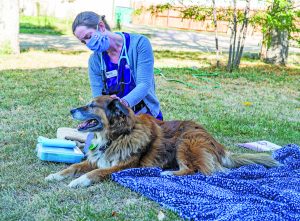“A sacred and precious time” – Part 2 of a series on pet loss
Pain can flow only as deep as the heart can love.
Even though we know that the lives of our pets are short compared to our own, we tend to avoid thinking about losing them.
“We actually grow stronger attachments with our pets than with other people,” said Adam Clark, a social worker and affiliate member of the faculty at the Institute for Human-Animal Connection in the Graduate School of Social Work at the University of Denver. “The security and authentic affection we get from them is different than any human relationships, which come with strings attached. We don’t think about what to do if an animal gets sick, runs away, or how to cope.”
In general, there are three options to help pet owners and their pet with the pet’s end-of-life journey: letting the pet die a natural death at home, a pet hospice program, and euthanasia, although in some situations all these options are available through pet hospice care.
“It can be a prolonged or very short journey,” said Mavi Graves, a veterinarian with Caring Pathways, which provides end of life care for pets and support for their owners. They service the Denver and Northern Colorado area, and have an office in Berthoud.
“We are available 24/7 and provide in-home euthanasia, in-home pet medical consults, tele-advice appointments, in-home hospice care and cremation, burial and memorial keepsakes,” she said.
“It’s a sacred time in a pet’s life and we want to do right by them.”
“It helped me tremendously to know having a vet come to the house was an option,” said Jessica Pierce, a bioethicist and author of several books on pets including “The Last Walk,” about her dog Ody’s end of life journey and her struggles to do the best she could to help him.
“Most pet owners don’t know how to read signs of pain, or how to figure out what resources there are to relieve discomfort.” When her book on pet loss came out she was flooded with responses from people who had lost an animal and were deeply traumatized, she said.
“You don’t have a hospice like you do with a human, you don’t have any of that support. You’re on your own. It can get really burdensome.”
“Neither the vet nor the family have all the tools that can help take them through these complicated and emotional decisions,” said Amir Shanan, a certified hospice and palliative care veterinarian.
Pet hospice care involves pet owners and a professional team working together to decide and do what is best for the animal, understand the animal’s quality of life and quality of the dying process experience, provide medical intervention as needed and as often as needed, and provide support for the pet owner(s).
“Most of hospice is about the journey,” said Shanan, “about learning to live with and accept the uncomfortable uncertainty in the journey, distinguishing between what bothers us as caregivers versus what bothers the animal, and helps us define destination: a good death. The ultimate goal for the owner is for them to have the least regrets and be able to look back and know they did make good decisions.”
Many pet owners hope their pets will pass away in their sleep, said Graves. For some, euthanasia is not an acceptable solution, perhaps because it is inconsistent with their religious beliefs.
Caring Pathways will provide a “comfort care packet” for these pet owners, she said, although they do not support natural death because of the suffering that can be involved.
“Mother Nature is not kind,” she said. “Death can be brutal.”
Caring Pathways will provide medications and heavy sedatives in these situations.
“They will put the pet into a deep sleep if they are in the active phase of dying,” she said. “It will help them transition to death naturally.”
It’s not always easy to tell when is the right time to euthanize an animal when that is an acceptable option. A veterinarian can help the owner make that decision.
“To me, euthanasia is a choice to prevent or end suffering,” said Clark. “It’s a quality of life decision.”
Many pet owners feel it is too soon and prolongs the decision until a crisis occurs, he said, resulting in more pain and suffering for the animal.
“It’s a sacred and precious time. It’s better to let them go on a good day than a bad day. They can have treats and look in their family’s eyes,” said Graves.
Planning ahead for euthanasia can be helpful for the family and the pet. Some people create beautiful final memories by completing things on a bucket list that their pet will enjoy. Some bring a favorite toy for an animal to have during the process, so the animal will die happy, said Coleen Ellis, a self-described Pet Loss Pioneer who travels around the world to give talks on pet loss.
“Encourage children to write a letter and read it to the animal and bring treats in,” she said. “Gives them an opportunity to ask questions, and gives them honest answers, lets them do their own ritual if they like, and lets them know it’s okay to be sad,” she said.
Ellis encourages pet owners to give their surviving pets an opportunity to say goodbye too.
“It’s profound to watch what happens. Some won’t leave the body, some show emotion and some don’t, they may lay on their dead companion or try to bury them by pushing dirt over on them. Encourage them to see the deceased pet, to confirm the death through their sense of smell. Then let them do what they want to do.”
- August, 23 2019

Colorado Rose Cake Co. wins The Knot&...
By Shelley Widhalm The Surveyor Though Colorado Rose Cake Co. won multiple awards, what’s more...
- April, 07 2022

Larimer County Sheriff, commissioner ...
There are seven offices up for grabs in Larimer County this November including a race...
- November, 18 2021

Partial lunar eclipse over Berthoud
A partial lunar eclipse is set to take place over North America on Thursday night...
- October, 05 2018

Over $21,000 raised for BHS golf
Courtesy photo - On Sept. 17 at Berthoud’s own TPC...
- March, 08 2018

Engagement Announcement
Tiffany Sieu of Denver, Colo., and...
- July, 06 2018

Town of Berthoud Parks Master Plan pu...
Special to the Surveyor On Monday, July 9, at 6:15 pm the PORT committee will...

Unified basketball comes to Turner Middle School
Community News

Mike Grace says goodbye as Brett Wing joins town board
Community News
POLICEBLOTTER
Community News
Northern Water sets C-BT quota at 70% for 2024
Community News

Emotions run high during Revere Property hearing
Community News
Snowpack at 119% above normal
Community News

Karspeck to serve third term as Berthoud mayor
Community News
COMMUNITY CALENDAR:
Community Calendar – add an event
Homestead Fine Art Gallery First Fridays OPEN HOUSE
03 May 4:00 PM - 7:00 PM
Homestead Fine Art Gallery First Fridays OPEN HOUSE
07 Jun 4:00 PM - 7:00 PM
Homestead Fine Art Gallery First Fridays OPEN HOUSE
05 Jul 4:00 PM - 7:00 PM
Homestead Fine Art Gallery First Fridays OPEN HOUSE
02 Aug 4:00 PM - 7:00 PM
Homestead Fine Art Gallery First Fridays OPEN HOUSE
06 Sep 4:00 PM - 7:00 PM
Homestead Fine Art Gallery First Fridays OPEN HOUSE
04 Oct 4:00 PM - 7:00 PM


